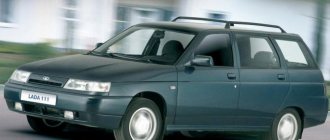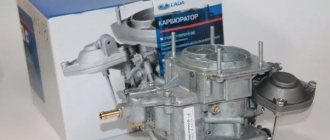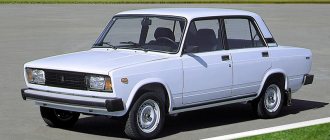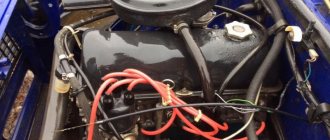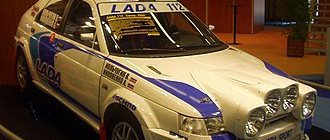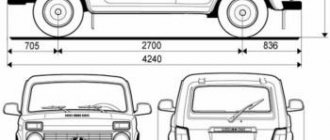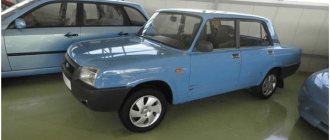| Options | Dimensions | Weight, kg |
| 1.3MT 21072 | 4128 x 1620 x 1435 | 1030 |
| 1.6MT 21074 | 4128 x 1620 x 1435 | 1030 |
| 1.3 MT 21079 Special version for the police | 4145 x 1620 x 1440 | 1040 |
| 1.5 MT5 2107 | 4145 x 1620 x 1446 | 1030 |
| 1.5 MT4 2107 | 4145 x 1620 x 1446 | 1030 |
| 1.5MT 2107-20 | 4145 x 1620 x 1446 | 1060 |
| 1.6 MT3 Standard | 4145 x 1620 x 1446 | 1060 |
| 1.6MT5 | 4145 x 1620 x 1446 | 1060 |
| 1.6MT3 | 4145 x 1620 x 1446 | 1060 |
| 1.6 MT5 Standard | 4145 x 1620 x 1446 | 1060 |
| 1.6 MT2 Standard | 4145 x 1620 x 1446 | 1060 |
| 1.6MT2 | 4145 x 1620 x 1446 | 1060 |
| 1.6MT3 | 4145 x 1620 x 1446 | 1060 |
| 1.6MT1 | 4145 x 1620 x 1446 | 1060 |
| 1.6 MT3 Standard | 4145 x 1620 x 1446 | 1060 |
| 1.6 MT5 Standard | 4145 x 1620 x 1446 | 1060 |
| 1.6MT 21074 | 4145 x 1620 x 1446 | 1060 |
| 1.7MT 2107 | 4145 x 1620 x 1446 | 1060 |
Production of the legendary seven at the Volzhsky Automobile Plant began in March 1982 and continued for more than 30 years.
The car still enjoys well-deserved popularity in our country and abroad. The dimensions of the car allow it to be classified as class B according to the international standard or group 2 according to the national standard. VAZ 2107 is currently being assembled at Izhmash and in the Chechen Republic. The Seven was exported under the name Lada 1500, Riva or Nova. It is an improved luxury version of the 2105 model. A number of changes were made to the design of the prototype, in particular the electrical circuit, attachments and the engine itself were changed. The VAZ 2107 has an improved interior; the front row has seats with integrated headrests.
Technical characteristics of VAZ-21074 injector
The most significant feature of the VAZ-21074 model that appeared in the early 80s, which distinguished it from other modifications of the “seven”, was its equipment with a 1.6-liter VAZ-2106 engine, which initially only ran on gasoline with an octane rating of 93 or higher. Subsequently, the compression ratio was lowered, which made it possible to use lower grade fuel.
Table: technical characteristics of VAZ-21074
| Parameter | Meaning |
| Engine power, l. With. | 75 |
| Engine capacity, l | 1,6 |
| Torque, Nm/rev. per minute | 3750 |
| Number of cylinders | 4 |
| Cylinder arrangement | in-line |
| Acceleration time to 100 km/h, seconds | 15 |
| Maximum speed, km/h | 150 |
| Fuel consumption (city/highway/mixed mode), l/100 km | 9,7/7,3/8,5 |
| Transmission | 5 manual transmission |
| Front suspension | independent multi-link |
| Rear suspension | dependent |
| Front brakes | disk |
| Rear brakes | drums |
| Tire size | 175/65/R13 |
| Disk size | 5Jx13 |
| Body type | sedan |
| Length, m | 4,145 |
| Width, m | 1,62 |
| Height, m | 1,446 |
| Wheelbase, m | 2,424 |
| Ground clearance, cm | 17 |
| Front track, m | 1,365 |
| Rear track, m | 1,321 |
| Curb weight, t | 1,06 |
| Gross weight, t | 1,46 |
| Number of doors | 4 |
| Number of seats | 5 |
| Drive unit | rear |
The dynamic performance of the VAZ-21074 is inferior to most budget foreign cars, but domestic car enthusiasts appreciate the “seven” for other qualities: spare parts for the car are inexpensive and publicly available, even a novice driver can repair almost any component and unit on his own. In addition, the machine is extremely unpretentious and adapted for operation in Russian conditions.
Video: the owner of a VAZ-21074 injector shares his impressions of the car
The engine from the VAZ-2106 was installed on the VAZ-21074 without changes: among other things, the camshaft chain drive was left, which, compared to the belt drive (used in the VAZ-2105), is more durable and reliable, although noisier. There are two valves for each of the four cylinders.
Compared to previous models, the gearbox has been noticeably improved, featuring a fifth speed with a ratio of 0.819. The gear ratios of all other speeds have been reduced in relation to previous analogues, as a result of which the gearbox operates more “softly”. The rear axle gearbox, borrowed from the 6, is equipped with a self-locking differential with 22 splines.
The DAAZ 2107–1107010–20 carburetor, which was installed on the VAZ-21074 until 2006, established itself as a fairly reliable mechanism, which, however, was very sensitive to fuel quality. The appearance of the injector added to the attractiveness of the model, thanks to new capabilities: now it was possible, by reprogramming the control unit, to change the engine parameters - to make it more economical or, conversely, powerful and responsive.
VAZ-21074 is equipped with a 75 hp engine. With. volume 1.6 l
The front pair of wheels has an independent suspension, the rear one has a rigid beam, making the car quite stable when cornering. The fuel tank holds 39 liters and allows you to travel 400 km without refueling. In addition to the fuel tank, the VAZ-21074 is equipped with a number of other refueling tanks, including:
- cooling system, including a radiator, engine cooling jacket, expansion tank. The system is filled with coolant with a volume of 9.85 liters;
- 5-speed manual transmission housing - 1.35 liters of TAD-17 oil;
- engine crankcase - 3.75 liters of engine oil;
- rear axle - 1.3 liters of TAD-17 oil;
- steering column housing - 215 ml hypoid oil;
- windshield washer - 2 liters of liquid;
- hydraulic clutch - 200 ml of brake fluid.
For the anti-corrosion coating of the bottom, polyvinyl chloride plastisol D-11A is used. Having a maximum speed of 150 km/h, the car accelerates to “hundreds” in 15 seconds. From its closest predecessor, the “five,” the VAZ-21074 received a brake system and a similar appearance. The two models differ:
- shapes of the trunk and hood;
- radiator grilles;
- rear lights;
- chrome trim on the bumpers.
Among the differences between the VAZ-21074 and VAZ-2105 is the shape of the rear lights
Fuel consumption
- Fuel consumption in urban conditions is 9.4 liters per 100 km.
- On a flat road at cruising speed it will already be 6.9 liters per 100 km.
- In mixed mode, consumption will be from 8 to 9 liters per 100 km. Such figures do not allow us to call this engine economical, but in this case a lot depends on the driver himself.
- Another parameter that depends on the driver is oil consumption per 100 km. For the average driver of a car with this engine, it is 700 g per 100 km. This, of course, is not small, but with careful driving you can reduce this consumption down to 450-500 g/100 km.
- The weight of the 2103 engine when fully assembled is 121 kg.
Model review: VAZ 2104 without embellishment
Few people know that the VAZ 2104 (“four”) also bears the foreign name Lada Nova Break. This is a five-seater station wagon, which belongs to the second generation of AvtoVAZ “classics”.
The first models left the factory in September 1984 and thereby replaced the first generation station wagon - VAZ 2102. Although for another year (until 1985) the Volzhsky Automobile Plant produced both models simultaneously.
VAZ 2104 cars were created on the basis of the VAZ 2105, only they had significant differences:
- extended rear part;
- folding rear bench;
- increased gas tank up to 45 liters;
- rear wipers with washer.
It must be said that the “four” were actively exported to other countries. In total, 1,142,000 VAZ 2104 units were produced.
Along with the VAZ 2104, its modification was also produced - the VAZ 21043. This is a more powerful car with a 1.5 liter carburetor engine and a five-speed gearbox.
Video: review of the Quartet
Weight of passenger cars in tabular format
We present to your attention a table that shows the weight of the car by brand.
| car model | Curb weight |
| Weight of the Oka 1111 car, weight of the Okushka | 635 kg |
| Weight of the car Oka 1113 | 645 kg |
| Weight of a VAZ 2101 car, weight of a penny | 955 kg |
| Weight of the VAZ 2102 car | 1010 kg |
| Weight of the VAZ 2103 car | 965 kg |
| Weight of the car VAZ 2104, weight of tens 2110 | 1020 kg |
| The weight of the VAZ 2105 car, the weight of the five | 1060 kg |
| Weight of the VAZ 2106 car, weight of the six | 1045 kg |
| Weight of the VAZ 2107 car, weight of the seven | 1049 kg |
| Weight of the VAZ 2108 car | 945 kg |
| Weight of the VAZ 2109 car, weight of the nine | 915 kg |
| Weight of the VAZ 2111 car | 1055 kg |
| Weight of a VAZ 2112 car, weight of a twelve-wheeler | 1040 kg |
| Weight of the VAZ 2113 car | 975 kg |
| Weight of the VAZ 2114 car, weight of the four | 985 kg |
| Weight of the VAZ 2115 car, weight of the tag | 1000 kg |
| Weight of the VAZ 2116 car | 1276 kg |
| Weight of the VAZ 2117 car | 1080 kg |
| Weight of the Niva 2121 car | 1150 kg |
| How much does a Chevrolet Cruze weigh (Chevrolet Cruze weight) | 1285-1315 kg |
| How much does a Chevrolet Niva weigh (Chevrolet Niva weight) | 1410 kg |
| How much does a GAZ (Volga) weigh, the weight of a Volga is 24 | 1420 kg |
| How much does GAZ 2402, GAZ 2403, GAZ 2404 weigh? | 1550 kg |
| How much does GAZ 2407 weigh? | 1560 kg |
| Car weight Moskvich 314 | 1045 kg |
| Weight Moskvich 2140 | 1080 kg |
| Weight Moskvich 2141 | 1055 kg |
| Car weight Moskvich 2335, 407, 408 | 990 kg |
| How much does a UAZ 3962, UAZ 452 weigh, how much does a UAZ loaf weigh? | 1825 kg |
| How much does UAZ 469 weigh? | 1650 kg |
| How much does UAZ Patriot weigh? | 2070 kg |
| How much does UAZ Hunter weigh? | 1815 kg |
| How much does Nissan weigh (weight of nissan x-trail car) | 1410-1690 kg |
| How much does Qashqai weigh (weight of Nissan Qashqai car) | 1297-1568 kg |
| How much does a Nissan Juke weigh (Nissan Beetle weight) | 1162 kg |
| Ford Focus car weight (how much does a Ford Focus weigh) | 965-1007 kg |
| Weight of the Ford Focus 2 car (how much does the Ford Focus 2 weigh) | 1345 kg |
| Weight of the Ford Focus 3 car (how much does the Ford Focus 3 weigh) | 1461-1484 kg |
| Ford Kuga car weight (how much does a Ford Kuga weigh) | 1608-1655 kg |
| Weight of the Ford Escort (how much does the Ford Escort weigh) | 890-965 kg |
| Weight of the Renault Logan car (how much does the Renault Logan weigh) | 957-1165 kg |
| Renault Duster car weight (how much does a Renault Duster weigh) | 1340-1450 kg |
| Renault Sandero car weight (how much does a Renault Sandero weigh) | 941 kg |
| Weight of the Opel Mokka car (how much does the Opel Mokka weigh) | 1329-1484 kg |
| Weight of the Opel Astra car (how much does the Opel Astra weigh) | 950-1105 kg |
| Mazda 3 car weight (how much does mazda 3 weigh) | 1245-1306 kg |
| Weight of the Mazda CX-5 (how much does the Mazda CX-5 weigh) | 2035 kg |
| Mazda 6 car weight (how much does mazda 6 weigh) | 1245-1565 kg |
| Volkswagen car weight (how much does a Volkswagen Tuareg weigh) | 2165-2577 kg |
| Weight of a Volkswagen Polo car (how much does a Volkswagen Polo weigh) | 1173 kg |
| Weight of the Volkswagen Passat car (how much does the Volkswagen Passat weigh) | 1260-1747 kg |
| How much does a Toyota Camry weigh (weight of a Toyota Camry) | 1312-1610 kg |
| How much does Toyota Corolla weigh (weight of Toyota Corolla) | 1215-1435 kg |
| How much does a Toyota Celica weigh (Toyota Celica weight) | 1000-1468 kg |
| How much does a Toyota Land Cruiser weigh (Land Cruiser weight) | 1896-2715 kg |
| How much does the Skoda Octavia weigh (weight of Skoda Octavia) | 1210-1430 kg |
| How much does the Skoda Fabia weigh (Skoda Fabia weight) | 1015-1220 kg |
| How much does the Skoda Yeti weigh (Skoda Yeti weight) | 1505-1520 kg |
| How much does a Kia Sportage weigh (KIA Sportage weight) | 1418-1670 kg |
| How much does Kia Sid weigh (weight of KIA Ceed) | 1163-1385 kg |
| How much does the Kia Picanto weigh (KIA Picanto weight) | 829-984 kg |
Thus, it turns out that if we take, so to speak, “in general for the hospital,” then the average weight of a passenger car is approximately from 1 to 1.5 tons, and if we talk about SUVs, then the whole weight already shifts from 1.7 tons to 2. 5 tons.
weight of a passenger car, how much does OKA weigh, how much does a car weigh, weight of a car, how much does a Matiz weigh, how much does a Matiz weigh, weight of a Skoda car, weight of an Audi
Hood of VAZ 2107
VAZ 2107 owners often modify the hood of the car. First of all, the lid stop, which was made at the factory in an extremely inconvenient way, changes. First you need to remove it from the latch and only then close it. On the VAZ 2106, the same stop is designed much simpler and more functional.
Installing an air intake on the hood
An air intake or snorkel is often installed on the hood of the VAZ 2107, which improves the appearance of the car and helps cool the engine. It is mounted so that air flows directly onto the air filter. Sometimes additional pipes are installed to the main air intake to increase cooling efficiency.
The snorkel is usually made by hand. In this case, it is better to use durable plastic or metal as a material. The air intake is mounted as follows.
- A U-shaped hole is cut in the hood with a grinder.
- The cut out part of the hood is bent to form the snorkel profile.
- Triangular metal pieces are welded along the edges to cover the ends of the part.
- The hood is puttied and painted to match the body color.
When cutting the hood, it is important not to touch the stiffeners provided by the design. Otherwise, the strength of the body will noticeably decrease
Hood lock
Sometimes car owners modify the hood lock of the VAZ 2107. If it does not work well or fails, the mechanism is dismantled. It is recommended to first outline the lock with a marker - this will avoid adjusting a new or restored lock. The mechanism is removed in the following order.
- The hood opens.
- The lock cable clamps come out of their seats.
- The bent end of the cable is straightened with pliers. The fixing sleeve is removed.
- Use a 10mm wrench to unscrew the lock nuts.
- The lock is removed from the pins.
- A well-oiled new lock is installed.
When replacing the cable, it is first disconnected from the lever handle. This is done from the salon. Then the cable is pulled out of its sheath. Nowadays, cables are often sold complete with a sheath. In this case, when replacing the old cable, it is pulled out along with the casing.
Numbers on engines of subsequent generations of Lada cars
Where is the engine number on a VAZ?
Knowing where the car engine number is located is useful for any motorist; it is especially important to know its location when buying a car, as well as repairing and replacing the engine.
Finding the engine number on VAZ cars is not difficult, the main thing is to know where to look. On the first VAZ 2101, 2102, 2103 cars, the engine number is located on a special area of the cylinder block, later on cars 2104, 2105, 2106, 2107, Niva, VAZ began to put the engine number above the oil filter. On the eighth, ninth and tenth series of VAZ cars, the engine number is printed on the top of the rear wall of the block, next to the distributor breaker.
REVIEW OF THE VAZ-21074 INJECTOR MODEL
The beginning of serial production of VAZ-21074 cars dates back to 1982, when the first copies of this model rolled off the assembly line of the Volzhsky Automobile Plant. At that time, the car was equipped with a carburetor power system: the injector on the VAZ-21074 appeared only in 2006. The advantages of the injection method of fuel supply are no longer a revelation to anyone, and after this system was implemented on the VAZ-21074:
- the engine began to start better in conditions of negative temperatures, without requiring prolonged warm-up;
- at idle speed the engine began to operate more smoothly and quietly;
- fuel consumption has decreased.
The injection version of the VAZ-21074 replaced the carburetor version in 2006.
The disadvantages of the VAZ-21074 include:
- low location of the exhaust pipe catalyst, which increases the risk of damage to this expensive part;
- inaccessibility of some parts and sensors, which was a consequence of the fact that the old type of body was not designed for an injection system - in the carburetor version there is much more space under the hood;
- low level of noise insulation, which reduces the level of comfort of the car.
The presence of a computer control unit allows you to respond in a timely manner to the occurrence of malfunctions, since a signal about a breakdown is immediately sent to the instrument panel. The control circuit for the operation of the engine and its systems used in the VAZ-21074 allows you to control the composition of the fuel mixture, turn the fuel pump on and off using electronics, and continuously monitor all components and mechanisms.
The control circuit of the VAZ-21074 allows you to respond in a timely manner to malfunctions of systems and mechanisms
The control scheme includes:
- Motor diagnostic block;
- Tachometer;
- Control system fault monitoring lamp;
- Throttle sensor;
- Throttle valve;
- Radiator cooling fan;
- Fan relay;
- Control block;
- Ignition coil;
- Speed sensor;
- Ignition section;
- Temperature sensor;
- Crankshaft sensor;
- Fuel pump relay;
- Fuel tank;
- Gasoline pump;
- Bypass valve;
- Safety valve;
- Gravity valve;
- Fuel filter;
- Canister purge valve;
- Reception pipe;
- Oxygen sensor;
- Battery;
- Egnition lock;
- Main relay;
- Nozzle;
- Fuel pressure control;
- Idle air control;
- Air filter;
- Air flow sensor.
A plate with identification data of the VAZ-21074 car can be found on the bottom shelf of the air intake box, which is located under the hood near the windshield, closer to the passenger seat. Next to the plate (1) is stamped VIN (2) - the vehicle identification number.
The plate with the identification data of the VAZ-21074 car can be found on the bottom shelf of the air intake box
The passport data on the plate is:
- Parts number;
- Manufacturing plant;
- Indication of conformity and vehicle type approval number;
- An identification number;
- Power unit model;
- Maximum permissible force on the front axle;
- Maximum permissible load on the rear axle;
- Version and equipment;
- Maximum permitted vehicle weight;
- Maximum permitted weight with trailer.
The alphanumeric characters on the VIN number mean:
- the first three digits are the manufacturing plant code (in accordance with international standards);
- the next 6 digits are the VAZ model;
- Latin letter (or number) - year of manufacture of the model;
- the last 7 digits are the body number.
The VIN number can also be seen in the trunk on the left rear wheel arch connector.
The VIN number can also be seen in the trunk on the left rear wheel arch connector
Total information
ParametersVAZ 2107VAZ 21074VAZ 2107-20VAZ 21074-20
| Weight of the equipped vehicle, kg | 1060 | 1060 | 1060 | 1060 |
| Payload, kg | 400 | 400 | 400 | 400 |
| Permitted maximum weight, kg | 1460 | 1460 | 1460 | 1460 |
| Ground clearance of a vehicle with a permissible maximum weight, with tires 175/70 R13, not less, mm: | ||||
| to the front suspension cross member | 162 | 162 | 162 | 159 |
| to the rear axle beam | 157 | 157 | 157 | 154 |
| Permissible weight of cargo on the additional (top) luggage rack, kg | 50 | 50 | 50 | 50 |
| Maximum speed, km/h: | ||||
| with permissible maximum weight | 148 | 148 | — | — |
| with driver and passenger | 150 | 150 | 150 | 150 |
| Acceleration time from standstill to 100 km/h, s: | ||||
| with driver and one passenger | 17 | 16 | 17 | 16 |
| with permissible maximum weight | 19 | 17,5 | — | — |
| Minimum turning radius along the track of the outer front wheel, m | 5,6 | 5,6 | 5,6 | 5,6 |
| The greatest rise overcome by a car with a permissible maximum weight without acceleration in first gear, % | 36 | 36 | 36 | 36 |
Transmission
| Clutch | single-disk, dry, with hydraulic shutdown drive and central diaphragm spring |
| Transmission | mechanical, four- or five-speed, three-way, three-shaft, with synchronizers on all forward gears |
| Gear ratios: | |
| first | 3,67 |
| second | 2,10 |
| third | 1,36 |
| fourth | 1,0 |
| fifth | 0,82 |
| reverse | 3,53 |
| Cardan transmission | two-shaft, with intermediate support and elastic coupling |
| main gear | hypoid |
| Final drive ratio | gear ratio – 3.9 or 4.1 |
| Differential | conical, two-satellite |
Our scales
At the moment we have produced and installed:
- Home page
- About company
- News
- Dealers
- Certificates
- Contacts
- Products:
- Car weights
- Career scales
- Warehouse scales
- Livestock scales
- Railway scales
- Services:
- Modernization of scales
- Checking the scales
- Delivery of scales
- Installation of scales
- Automation systems
Owner's review of the VAZ 2107
My car is stored under a canopy, outside. Winter air temperatures in our region reach forty degrees, and this weather lasts for one and a half to two months a year. I want to say that I am satisfied with my “seven”. Since I use it every day, it starts without problems.
The first winter, before starting it, I heated the pan with a fan heater for half an hour, and didn’t even remove the battery at night. But after the winter I had to change the battery; I still started bringing a new one home in the second winter. To be honest, I bought the battery for 2000, and my friend – for 3500, we threw them away at the same time, judge for yourself. So, before next winter I installed a coolant heater, which is included in the system where the temperature sensor is installed. I set it to 220 network 30-40 minutes before launching it, I launch it without problems and immediately warm air blows out of the stove.
By the way, the design of the heating system leaves much to be desired. Air ducts that are directed on both sides of the cabin, in my opinion, only complicate the air supply. At the same time, a fairly powerful stream of air is directed at the driver’s feet. The lack of heat in the cabin begins to be felt at a temperature of -25-300C.
I would like to warn you that you should wash the VAZ 2107 2002 without using car shampoos. On mine, and, as far as I know, on cherry and eggplant-colored cars of that year, the paint does not tolerate strong chemicals, and stains remain. After my first visit to the car wash, I had to polish my car. But then I warned the workers, or washed them myself with household detergents.
Weight reduction
So, car developers have been fighting extra pounds for a long time. Success has been variable and it would be a stretch to say that any significant improvements have been achieved. As a rule, it is possible to lighten the body without affecting the standard linear dimensions of the VAZ 2107 body geometry using technologies that are innovative for a certain period of time. But innovations can be very expensive, and it is rarely possible to introduce them into general production.
Using the example of VAZ models, it happened like this: if one of the design bureaus managed to reduce the weight of the frame or internal combustion engine, then another bureau found and introduced devices that were enviably in demand at that moment into the car system, without which it was already unthinkable to imagine a modern vehicle. So we had to rack our brains again about how to reduce the weight of the car with new instruments and devices, and everything returned to normal.
So, if you take our “seven” and equip it with all the modern optional kit of an expensive foreign car, it will significantly lose dynamics and fuel consumption will increase.
Facing panel (apron) and front bumper
The facing panel or front apron on the “seven” plays more of a decorative role. But besides giving a stylish appearance, an apron also provides many benefits. In particular, thanks to it, during rain, water does not fly directly onto the windshield, but is cut off by this element.
The apron is located directly under the bumper and is a flexible shield that also serves to prevent damage to the front of the car from splashes from under the wheels.
This structural element of the body has special holes for the front bumper brackets and the radiator grille (the latter is attached to it). The apron, due to its “extreme” location (bottom and front), becomes vulnerable to impacts and corrosion. Connected to the body by spot welding.
The design of the "seven" apron must be thought out carefully and correspond to the shape and geometry of the entire car body, otherwise it will simply vomit at high speed. In addition, non-compliance with geometry and design will lead to increased fuel consumption at high speed.
The price for a front apron for a VAZ 2107 individually starts from 600 rubles. The part may be of different workmanship, have a different color and different design features.
Front aprons, sold as a separate element of body decor, come with special mounts to the bumper. As for the original Semerovo ones, they are welded, as mentioned above, to the car body.
The rear apron is also required and must have special fastening plates that ensure its immovable condition and prevent it from coming off on the road.
Front bumper
The bumper is not only designed to retain the energy of a frontal impact first, but also plays a significant role in the exterior design of the Seven. In other words, this is a beam located in front and protects the body from damage in minor collisions.
Thanks to modern synthetic-based materials, bumpers have become much lighter and more beautiful than they were before. Thus, elegant bumpers with bent edges also serve as spoilers, increasing the downforce of the car.
The front and rear bumpers on the VAZ 2107 are made of plastic or thin metal and have chrome trim. They are mounted using special brackets.
The front bumper is equipped with a platform for attaching a license plate and for this reason is 5 cm wider than the rear one.
Today, the owner of the “Seven” is offered three options for bumpers for the VAZ 2107: plastic, plastic with chrome lining, and with brackets for fastening. The price starts from 600 rubles.
Front bumper tuning
Modernizing the front bumper of the “Seven”, first of all, means improving the appearance. To be honest, the factory bumpers of the VAZ 2107 family look, to put it mildly, fake. They do not carry any visual, or even more importantly, high-quality functionality.
The implementation of the idea of tuning the bumper on a VAZ 2107 (the rear one is also possible) consists in strengthening it with a metal profile of an L-shaped section. In addition, to give a more aesthetic appearance, the part moves slightly from the body.
You need to work with the bumpers removed. Here's what to do:
- Place the pre-prepared reinforcing corner to the bumper and mark the mounting holes, and then drill them in the profile;
- The lower part of the profile bends forward. This creates a fastener for the lower bumper bolt;
- First, the amplifier is attached to the body, then the bumper is attached to it.
As a result, we get a massive bumper that is not afraid of light and medium impacts and looks much more impressive in appearance than the factory one.
Electric trunk lock
Now it’s time to deal with the trunk lid. If you're going to do some revision, do it until the end. There are several options for how to improve the VAZ 2107 trunk lock, remote, with a button and with an electric drive. Such tricks are explained by the fact that it is not always convenient to turn off the engine to open the trunk. And if you install an electric drive, then if you have an installed alarm system, it is easy to make a remote control of the lock.
Any electromagnetic lock can serve as an actuator. There are several varieties of them on sale; they may differ in size and stroke. The electric lock is attached directly to the trunk lid, preferably closer to the hinges, in order to reduce the load on them when opening the lid. The ideal solution for traction would be a cable or a strong steel guitar string, one end of which is attached to the lock tongue, and the other to the eye of the stem.
The connection diagram for the electric lock is shown in the photo, and the actuator must be turned on through any VAZ relay with four contacts. If there is an alarm, you can also include an electric lock in its circuit, then the trunk will open both from a button in the cabin and from the alarm remote control.
Memo to the driver of VAZ 2107
This is a reminder for drivers of the VAZ 2107 (also relevant for other classics), I decided to create it because minor technical questions often arise, and it takes a lot of time to find the answer. And here everything is in one place. Save this reminder in your bookmarks or on your page on a social network, and use the social network buttons under the article for your health.
So, VAZ 2107 technical characteristics, dimensions, parameters.
VAZ 2107 was produced from March 1982 to April 2012. It has been produced in Egypt since 2006 to this day.
It has a 5-seater sedan-type body, in-line 4-cylinder gasoline engines, paired with a 4 or 5-speed manual transmission. It is included in the class of subcompact cars, according to the European classification - class “B”. And not C, as they say on the forums. C class is Ford Focus, KIA Ceed, etc. Wheel formula 4x2, rear wheel drive. The ancestor is the Italian Fiat 124.
General parameters of the VAZ 2107
Length - 4145 mm Width - 1620 mm Height - 1446 mm Base - 2424 mm Front wheel track - 1365 mm Rear wheel track - 1321 mm Ground clearance - to the front suspension cross member - 159 mm, to the rear axle beam - 154, up to muffler housing - 120 mm. Not bad, for example in the Opel Zafira, only 150 mm to the highest point. Load capacity - 400 kg Trunk volume - 385 liters Curb weight - 1060 kg Gross weight - 1460 kg Towed trailer weight, without brakes - 300 kg, with brakes - 600 kg.
VAZ 2107 engines
The VAZ 2107 was equipped with several engines (for Russia and the USSR), these are:
- VAZ 2103 engine (8 class, 1500 cm3, 71 hp, carburetor)
- VAZ 2105 engine (8 class, 1300 cm3, 64 hp, carburetor, timing belt drive)
- VAZ 2106 engine (8 class, 1600 cm3, 79 hp, carburetor)
- VAZ 2104 engine (8 cells, 1500 cm5, 68 hp, central injection)
- VAZ 21067 engine (8 cells, 1600 cm3, 74 hp, distributed injection)
- RPD engine (rotary, 1300 cm3, 140 hp)
Piston diameter and stroke:
- for 1300 = 79 mm x 66 mm - for 1500 = 76 mm x 80 mm - for 1600 = 79 mm x 80 mm - for 1700 = 82 mm x 80 mm
Compression ratio for all engines - 8.5 Cylinder operating order: 1-3-4-2
For carburetor VAZ 2107, DAAZ 2107-1107010 carburetors and their modifications were used. A-92 gasoline is used as fuel.
The injector for Euro-3 standards is already designed for A-95 gasoline.
Spark plugs for VAZ 2107:
— for carburetor engines — A17DVR or A17DV-10; - for injector - A17DVRM.
Oil for VAZ 2107:
For all classic engines, the optimal choice is semi-synthetic 5W40. If your region has severe frosts, and most of the time it is below minus 30, then choose 0W40. If your frosts are not severe and the summer is hot, then the oil is better than 10W40.
Oil change is done once every 10,000 km
VAZ 2107 body
All-metal, load-bearing, with 4 doors. Body rigidity - 7200 Nm/deg.
The width of the VAZ 2107 interior, and all classics in general (from the rear door trims at the seat level) is 1250 mm. Between the central pillars of the cabin, at a level of 80 cm from the floor - 1234 mm.
The length of the front door opening of the VAZ 2107 (and all classics) is 889 mm, the rear door is 819 mm.
Dimensions of the trunk of the VAZ 2107:
Electrical equipment VAZ 2107
Wiring type: single-wire, negative on the car body (ground).
Battery: 6ST-55, capacity 55 Ah. Batteries with a capacity of 60 and 65 Amperes are also suitable, but you need to check the dimensions. Typically it is 242mm x 175mm x 192mm.
Operating voltage in the network: 13.6 -14.6 volts. The generator (G221) must deliver a current of no more than 1/10 of the battery capacity, i.e. approximately 2 to 5.5 Amps.
Ignition coil - B117 or B117-A (for carburetor engines) Starter - ST221
Lamp type:
— low and high beam lamp: H4 or AKP2-60+55 (in Russian) — side marker lamp and side turn signals: T4W or A12-4-1 — turn signal lamp in the headlight, fog lights, reverse and brake lights: P21W or A12-21-3 - license plate and interior lighting lamp: C5W or AC12-5-1
Weight of passenger cars in tabular format
We present to your attention a table that shows the weight of the car by brand.
| car model | Curb weight |
| Weight of the Oka 1111 car, weight of the Okushka | 635 kg |
| Weight of the car Oka 1113 | 645 kg |
| Weight of a VAZ 2101 car, weight of a penny | 955 kg |
| Weight of the VAZ 2102 car | 1010 kg |
| Weight of the VAZ 2103 car | 965 kg |
| Weight of the car VAZ 2104, weight of tens 2110 | 1020 kg |
| The weight of the VAZ 2105 car, the weight of the five | 1060 kg |
| Weight of the VAZ 2106 car, weight of the six | 1045 kg |
| Weight of the VAZ 2107 car, weight of the seven | 1049 kg |
| Weight of the VAZ 2108 car | 945 kg |
| Weight of the VAZ 2109 car, weight of the nine | 915 kg |
| Weight of the VAZ 2111 car | 1055 kg |
| Weight of a VAZ 2112 car, weight of a twelve-wheeler | 1040 kg |
| Weight of the VAZ 2113 car | 975 kg |
| Weight of the VAZ 2114 car, weight of the four | 985 kg |
| Weight of the VAZ 2115 car, weight of the tag | 1000 kg |
| Weight of the VAZ 2116 car | 1276 kg |
| Weight of the VAZ 2117 car | 1080 kg |
| Weight of the Niva 2121 car | 1150 kg |
| How much does a Chevrolet Cruze weigh (Chevrolet Cruze weight) | 1285-1315 kg |
| How much does a Chevrolet Niva weigh (Chevrolet Niva weight) | 1410 kg |
| How much does a GAZ (Volga) weigh, the weight of a Volga 24 | 1420 kg |
| How much does GAZ 2402, GAZ 2403, GAZ 2404 weigh? | 1550 kg |
| How much does GAZ 2407 weigh? | 1560 kg |
| Car weight Moskvich 314 | 1045 kg |
| Weight Moskvich 2140 | 1080 kg |
| Weight Moskvich 2141 | 1055 kg |
| Car weight Moskvich 2335, 407, 408 | 990 kg |
| How much does a UAZ 3962, UAZ 452 weigh, how much does a UAZ loaf weigh? | 1825 kg |
| How much does UAZ 469 weigh? | 1650 kg |
| How much does UAZ Patriot weigh? | 2070 kg |
| How much does UAZ Hunter weigh? | 1815 kg |
| How much does Nissan weigh (weight of nissan x-trail car) | 1410-1690 kg |
| How much does Qashqai weigh (weight of Nissan Qashqai car) | 1297-1568 kg |
| How much does Nissan Juke weigh (Nissan Beetle weight) | 1162 kg |
| Ford Focus car weight (how much does a Ford Focus weigh) | 965-1007 kg |
| Weight of the Ford Focus 2 car (how much does the Ford Focus 2 weigh) | 1345 kg |
| Weight of the Ford Focus 3 car (how much does the Ford Focus 3 weigh) | 1461-1484 kg |
| Ford Kuga car weight (how much does a Ford Kuga weigh) | 1608-1655 kg |
| Ford Escort car weight (how much does a Ford Escort weigh) | 890-965 kg |
| Weight of the Renault Logan car (how much does the Renault Logan weigh) | 957-1165 kg |
| Renault Duster car weight (how much does a Renault Duster weigh) | 1340-1450 kg |
| Renault Sandero car weight (how much does a Renault Sandero weigh) | 941 kg |
| Weight of the Opel Mokka car (how much does the Opel Mokka weigh) | 1329-1484 kg |
| Weight of the Opel Astra car (how much does the Opel Astra weigh) | 950-1105 kg |
| Mazda 3 car weight (how much does Mazda 3 weigh) | 1245-1306 kg |
| Weight of the Mazda CX-5 (how much does the Mazda CX-5 weigh) | 2035 kg |
| Mazda 6 car weight (how much does Mazda 6 weigh) | 1245-1565 kg |
| Volkswagen car weight (how much does a Volkswagen Tuareg weigh) | 2165-2577 kg |
| Weight of a Volkswagen Polo car (how much does a Volkswagen Polo weigh) | 1173 kg |
| Weight of the Volkswagen Passat car (how much does the Volkswagen Passat weigh) | 1260-1747 kg |
| How much does a Toyota Camry weigh (Toyota Camry weight) | 1312-1610 kg |
| How much does Toyota Corolla weigh (weight of Toyota Corolla) | 1215-1435 kg |
| How much does a Toyota Celica weigh (Toyota Celica weight) | 1000-1468 kg |
| How much does a Toyota Land Cruiser weigh (Land Cruiser weight) | 1896-2715 kg |
| How much does the Skoda Octavia weigh (Skoda Octavia weight) | 1210-1430 kg |
| How much does the Skoda Fabia weigh (Skoda Fabia weight) | 1015-1220 kg |
| How much does the Skoda Yeti weigh (Skoda Yeti weight) | 1505-1520 kg |
| How much does a Kia Sportage weigh (KIA Sportage weight) | 1418-1670 kg |
| How much does Kia Sid weigh (KIA Ceed weight) | 1163-1385 kg |
| How much does the Kia Picanto weigh (KIA Picanto weight) | 829-984 kg |
Thus, it turns out that if we take, so to speak, “in general for the hospital,” then the average weight of a passenger car is approximately from 1 to 1.5 tons, and if we talk about SUVs, then the whole weight already shifts from 1.7 tons to 2. 5 tons.
weight of a passenger car, how much does OKA weigh, how much does a car weigh, weight of a car, how much does a Matiz weigh, how much does a Matiz weigh, weight of a Skoda car, weight of an Audi
How much does the VAZ weigh?
Perhaps one of the most popular cars in the post-Soviet space was, is and remains the VAZ. This car has captivated many generations. However, how did it all begin? When was the first VAZ car produced and how much did it weigh? You will learn the answers to these and other questions from this article. The first VAZ car was produced by the Volzhsky Automobile Plant on April 19, 1970. The make of this car was VAZ-2101 “Zhiguli”. Its production was carried out according to the analogue of the Fiat concern. Moreover, the VAZ owes its appearance to this particular brand of the Fiat 124 car produced in 1966. Here, in fact, is it: As a result of some design improvements, the first domestic car, the VAZ 2101 of 1970, was produced:
The weight of this car was 955 kg. Moreover, of this mass the engine weighed 114 kg.
It has not lost its popularity to this day. In 2000, it was recognized as the best car among eighty thousand car enthusiasts surveyed in the CIS countries and Russia. It was named the best car of the century, VAZ 2101. At the time of its production, it was considered the most comfortable, reliable and modern domestic car. Its presence was a sign of wealth and prosperity!
But the Volzhsky Automobile Plant did not stop there. He created entire collections of this car. Each of them differed in its configuration, as well as its total weight. Therefore, now we will compare some VAZ models by their weight.
- VAZ 2102 has a weight of 1010 kg.
- VAZ 2103 weighs 965 kg.
- VAZ 2104 has a weight of 1020 kg.
- VAZ 2105 has a weight of 1060 kg.
- VAZ 2106 weighs 1045 kg.
- VAZ 2107 weighs 1049 kg.
- VAZ 2108 weighs 945 kg.
- VAZ 2109 weighs 915 kg.
- VAZ 2110 has a weight of 1020 kg.
- VAZ 2111 weighs 1055 kg.
- VAZ 2112 has a weight of 1060 kg.
- VAZ 2113 weighs 975 kg.
- VAZ 2114 weighs 985 kg.
- VAZ 2115 weighs 1000 kg.
- VAZ 2116 weighs 1276 kg.
- VAZ 2117 weighs 1110 kg.
- VAZ 2118 has a weight of 1110 kg.
- VAZ 2119 has a weight of 1110 kg.
- VAZ 2120 has a weight of 1110 kg.
- VAZ 2121 has a weight of 1550 kg.
- VAZ 2122 has a weight of 1122 kg.
- VAZ 2123 has a weight of 1300 kg.
But this is the total weight of a VAZ car. As for some parts of the car, the weight of, for example, a VAZ 2106 can be decomposed as follows:
- The weight of the engine with equipment is 140 kilograms.
- The weight of the gearbox is 26 kilograms.
- The weight of the square shaft is 10 kilograms.
- The weight of the rear axle is 52 kilograms.
- The weight of the radiator is 7 kilograms.
- Body weight – 280 kilograms.
On average, the weight of all components of a VAZ car has approximately the same mass. Throughout the entire period of existence of this car, quite interesting facts have been recorded that simply cannot be ignored. It’s hard to imagine that a car weighing an average of 1 ton is very popular.
So, the VAZ 2121 Niva car is not only the most popular throughout the USSR, but also the most exported. Just imagine, this model was produced in 1.8 million cars. And of this amount, 500,000 were sold to more than 100 countries. As we remember, the weight of the VAZ 2121 is 1550 kilograms. This means that over the entire period, 775,000,000 kilograms of this car were sold! Also, this particular model of all Soviet cars was driven in Japan. As for the design of the VAZ 2108, it was developed by the currently well-known company Porshe. The weight of its engine is 127.3 kilograms. This became necessary due to the fact that the demand for this brand of car was greatly reduced. For this reason, they decided to modernize it.
Moreover, the VAZ car became more popular because the Lada car was the first car of the famous Formula 1 racer - Kimi Raikkonen. His father loved this car extremely much for its reliability.
So, we learned that each VAZ car model has its own separate weight. But throughout the history of its existence and production, it has not undergone major changes.
Features of car recycling
Before you scrap your car, you should familiarize yourself with the principles of this procedure. The average weight of a vehicle is 1000 kg. If the entire car can be recycled, the collection point will deduct 30% for clogging. The latter includes all non-metallic elements, pollution, etc.
Let's consider how much a car for scrap metal weighs using the example of a VAZ 2105. The weight of the latter is 955 kg. Thus, taking away the blockage, we get about 660 kg. You should also take into account the price of scrap, which differs depending on the city. As a rule, in megacities, the number of rubles received for a car will significantly exceed the amount earned in a similar organization in a small locality.
Before calculating the profit from a scrapped car, you need to take into account transportation costs. If the car is a pile of metal, you need to take care of a tow truck. If there are spinning wheels and functional steering, the car can be transported in tow. Then, this expense item will not be so significant. Therefore, in order to calculate how much a Zhiguli costs when scrapped, it is not enough to know how much a VAZ 2109 or 21099 weighs for scrap metal (915 kg). It is necessary to take into account the features of recycling and the requirements of collection points. It would be useful to know the average cost of scrap metal in the region. Additional awareness will allow you to avoid fraud on the part of unscrupulous receivers.
Despite the fact that disassembling a car is a labor-intensive procedure, many owners still decide to take this step. Thus, you can sort ferrous and non-ferrous metals and hand them over separately, removing the good parts. From an economic point of view, the procedure will be justified.
Let's consider how much a VAZ 2106 weighs for scrap metal based on individual significant structural elements:
- body – about 300 kg;
- bridge – 52 kg;
- motor – 140 kg.
It should be noted that dismantling machine parts requires a lot of time and certain skills. In the absence of the latter, it would be more rational to recycle it entirely.
Description of the salon
Having first appeared in 1982, the VAZ 2107 did not differ from its predecessors and competitors in any modern devices or design. However, even those little things that the manufacturer decided to introduce into the new Lada model played into the hands: the car became more convenient and attractive for drivers.
Interior trim
The interior trim was fully consistent with Soviet ideas about fashion. For example, higher quality plastic and wear-resistant fabrics were used. For the first time, the seats acquired an anatomical shape and received comfortable headrests. In general, the VAZ 2107 was the first in the manufacturer’s line to receive the title of a comfortable car for people.
Dashboard
However, if the interior, at the very least, stood out from similar AvtoVAZ models, the instrument panel was always made in strict accordance with existing standards. We can say that the dashboard is featureless, although it houses the tachometer and additional services of instruments and sensors.
Gear shift diagram
The gearbox on the VAZ 2107 is needed to transmit torque from the engine to the transmission.
All 7 gearboxes also have reverse gear. The transmission itself is necessarily sewn into the housing with a lever located on it to change gears.
Video: how to change gears in a car
Thus, the VAZ 2107 model successfully continued the traditions of the domestic automotive industry. The modification is considered one of the most popular in Russia, as it combines build quality, the presence of only the instruments and mechanisms necessary for driving, and an affordable price.
- Body kit for Lada 2106
- Salon for VAZ 2106 price
- Fuel line diagram for VAZ 2110 injector
- Spare parts for VAZ 21074 injector
- Catalog VAZ 2107 injector
- Fuel filter in the tank
Wiper sizes
Factory wipers on the VAZ-2107 are 33 cm (13”). Despite the fact that 14” and 15” wipers are suitable for this car model, factory ones are considered the best option, since the motor is designed specifically for them. Despite the improvement, all glass on the VAZ-2107 remained the same size:
- wind – 1440×536×6;
- rear window – 1360×512×5;
- front door glass (pivot) – 346×255×5;
- front door (lowering) – 503×422×5;
- rear door (lowering) – 543×429×5;
- rear door glass (fixed) – 372×258×5.
All geometry control points also remained unchanged. They can be found on the drawings that come with the car. The standard dimensions of the aluminum stove radiator are 200×174×42. It is also suitable for other models, such as VAZ-2101, VAZ-2103, VAZ-2105.
History [edit | edit code]
Serial production of the VAZ-2104
(“fours”) was launched at the Volzhsky Automobile Plant in the second half of 1984. In parallel with the new model, a similar class car, the VAZ-2102 (“two”), was produced, which by April 1985 was completely forced out of the assembly line. The “four” received a number of original parts relating to the rear of the car from the “donor” car.
When creating this model, the designers were guided by an important feature of that time: the creation of a new model with minimal production costs and maximum consumer effect. Therefore, the VAZ-2105 model was taken as a basis.
After lengthening the roof, stampings appeared to increase rigidity. This body design allows you to place a long trunk on the roof, which is not recommended to be overloaded, since the design rigidity of the station wagon body is significantly lower than that of a sedan. The rear door opened upwards, and a completely new solution was used - a heated rear window and a windshield wiper - which until 1994 was used only in the production of cars for export, and then became standard.
At the end of the 1990s, an “improved” modification of the VAZ-21043-20
, equipped with a five-speed gearbox, roof rails, electrical equipment and an interior with anatomical front seats from the VAZ-2107, erroneously referred to for marketing purposes as VAZ-21047
. In fact, this index is carried by the version for countries with left-hand traffic and a 1.45 liter engine.
Salon
The interior for the new model was borrowed from the base model, with the exception of the rear seat. The folding rear seat allows you to increase the volume of the luggage compartment from 375 to 1340 liters, and then you can transport large cargo. The total vehicle load has increased to 455 kg. In the basic configuration, the interior trim is quite simple. The Spartan version assumes a standard panel with a minimum required set of instruments, upholstery and seats with standard removable faux leather headrests and rubber floor mats. The desire for greater comfort is proposed to be satisfied with improved seat upholstery made of brushed jersey, solid-molded door linings, brushed floor mats, an instrument panel with an additional center console, which has an expanded set of function keys and control equipment, and an original steering wheel.
Carburetor
The first cars in the series had a carburetor installed in the VAZ-21074. The technical characteristics of an engine with this type of fuel injection were as follows:
- fuel type - AI-95;
- engine power - 75 hp. With.;
- torque - 116 Nm (at 3750 rpm);
- fuel consumption (city) - 9.7 l/100 km;
- fuel consumption (highway) - 7.3 l/100 km;
- Acceleration time to 100 km/h - 15 seconds.
On the model with a vacuum corrector, a DAAZ 2107-1107010-20 carburetor was installed. Over the years of operation, this unit has proven its reliability and durability. Despite this, the carburetor system is very sensitive to fuel quality. Therefore, the manufacturer began installing a modern injection system on models of later years of production.
Chassis, steering and braking system
The front suspension of the VAZ 2107 has an independent double wishbone design with two shock absorbers and springs, as well as a stabilizer bar. The rear suspension is dependent with a rigid beam, which is connected to the body through one transverse and 4 longitudinal reaction rods. The suspension design is complemented by two hydraulic shock absorbers with coil springs.
wheels - 5Jxl3H2 (permissible offset 25-30 mm);
tires - 175/70R13 (165/70R13).
The steering mechanism of the VAZ 2107 is a globoidal “worm” driven by a double-ridge roller (gear ratio 16.4). Drive – three-link (2 lateral symmetrical rods, middle symmetrical rod, pendulum arm, swing arm, bipod).
The VAZ 2107 brake system has a foot (foot) drive through a vacuum booster. Its design also includes an emergency sensor and a brake fluid pressure regulator in the rear wheel drive. The parking (hand) brake is activated by a cable that engages the rear wheel chocks. The rear wheels are equipped with a drum-type brake mechanism.
The brake mechanism of the front wheels has a classic disc design with automatic clearance adjustment.
Refill containers
- Fuel tank (including 5 liter reserve) - holds 39 liters of gasoline
- Lubrication system (including oil filter) - holds 3.75 liters of oil
- Engine cooling system (including interior heater) - 9.85 liters of antifreeze
- Washer reservoir - 2 liters
- Gearbox housing - 1.35 liters of transmission oil (semi-synthetic GL-5 75W90) / for a 5-speed gearbox - 1.59 liters
- Rear axle housing - 1.3 liters semi-synthetic GL-5 (75W90)
- Clutch hydraulic system - 200 ml
- Brake system 660 ml

